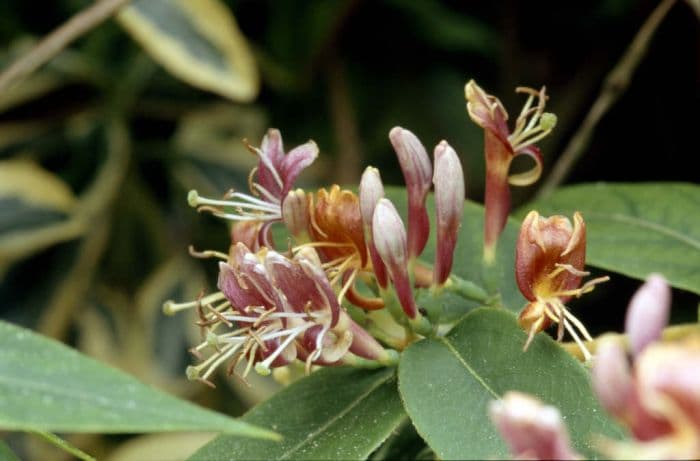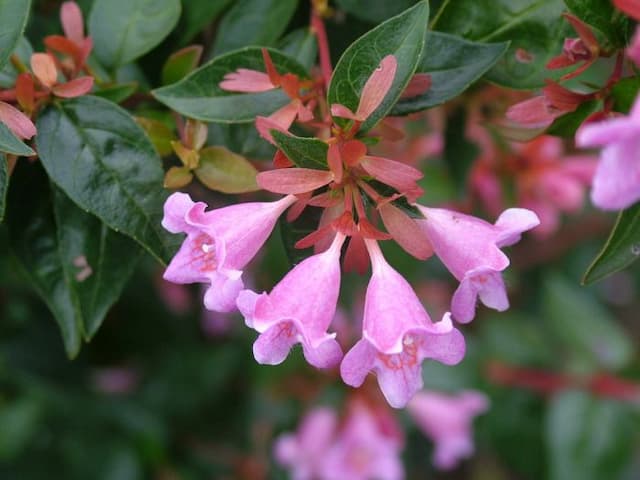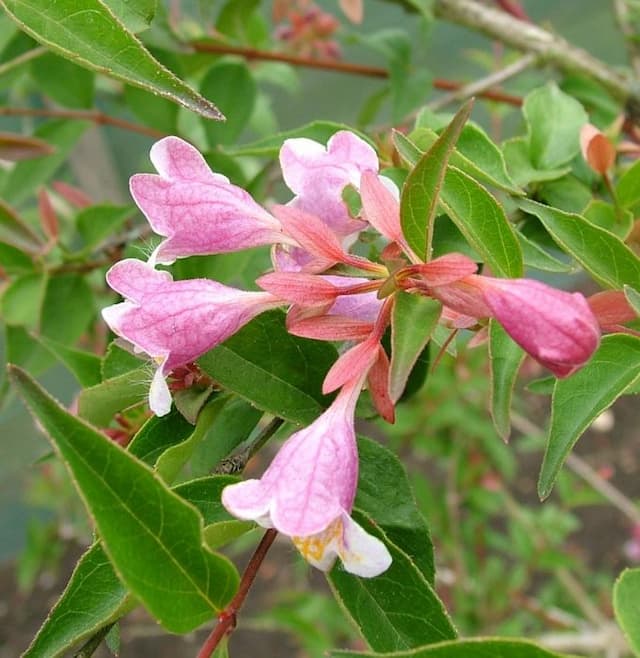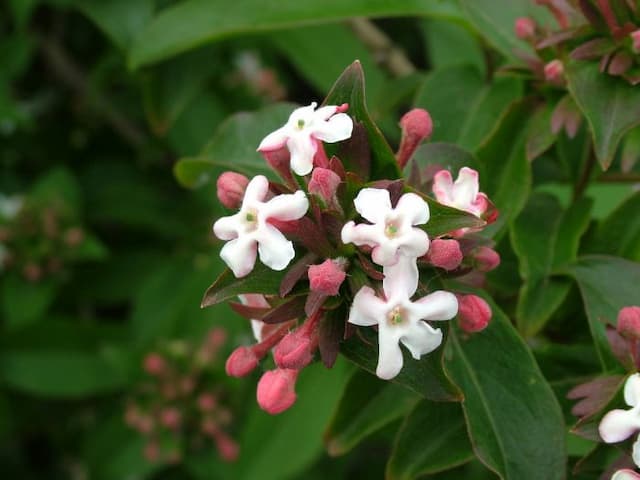Henry's Honeysuckle Lonicera henryi

ABOUT
Lonicera henryi, commonly known as Henry's honeysuckle, is an evergreen climber known for its attractive foliage and fragrant flowers. Its leaves are oval-shaped with a rich green color, often with a slightly glossy appearance. The leaves can sometimes have a purple-tinged hue, particularly during the colder months, giving the plant year-round interest. The flowers of Henry's honeysuckle are tubular and bountiful, usually a blend of yellow and reddish-purple tones. They bloom in clusters, presenting a lovely multi-colored appearance that can add a touch of vibrancy to a garden. These flowers are sweetly scented and tend to attract pollinators, including hummingbirds and butterflies, who are drawn to the nectar. Following the flowering period, Henry's honeysuckle may produce small, red berries that further increase its decorative appeal. These berries are generally favored by birds. The twining stems of the plant make it an excellent choice for growing on trellises, fences, or even as ground cover, with the vines spreading gracefully over the area they inhabit.
About this plant
 Names
NamesSynonyms
Henry's Honeysuckle, Evergreen Honeysuckle, Copper Honeysuckle.
Common names
Caprifolium henryi
 Toxicity
ToxicityTo humans
Henry's honeysuckle (Lonicera henryi) is not known to be toxic to humans. There is no widespread evidence or documentation that suggests this plant poses a significant risk if ingested. However, it is generally recommended to avoid eating any part of ornamental plants due to the potential for unknown individual sensitivities or the possibility of stomach upset.
To pets
Henry's honeysuckle (Lonicera henryi) is generally not listed among the plants that are toxic to pets like cats and dogs. However, it's important to note that even non-toxic plants can cause mild gastrointestinal upset if ingested in large quantities by pets. If any signs of illness are observed after a pet has ingested part of this plant, it is advisable to contact a veterinarian.
 Characteristics
CharacteristicsLife cycle
Perennials
Foliage type
Evergreen
Color of leaves
Green
Flower color
Yellow
Height
10 feet (3 meters)
Spread
6 feet (1.8 meters)
Plant type
Climber
Hardiness zones
4
Native area
China
Benefits
 General Benefits
General Benefits- Attractive flowers: Lonicera henryi bears beautiful tubular or trumpet-shaped flowers, which add aesthetic value to gardens.
- Habitat for wildlife: The flowers provide nectar for bees and other pollinating insects, while its dense foliage can offer shelter for birds.
- Growth habit: As a climbing plant, Henry's honeysuckle can be used to cover walls, trellises, or fences, providing a natural screen for privacy or decoration.
- Durable: It is known for being hardy and able to thrive in a variety of soil types and weather conditions, making it low maintenance.
- Year-round interest: The plant has semi-evergreen foliage that provides visual interest even in the colder months when other plants may have lost their leaves.
 Medical Properties
Medical PropertiesThis plant is not used for medical purposes.
 Air-purifying Qualities
Air-purifying QualitiesThis plant is not specifically known for air purifying qualities.
 Other Uses
Other Uses- Lonicera Henryi, commonly known as Henry's Honeysuckle, can be used as a natural fencing material due to its dense growth habit, providing privacy and reducing noise pollution.
- The twining vines of Henry's Honeysuckle make it suitable for decorating garden trellises and pergolas, offering aesthetic appeal and structure to garden designs.
- Horticultural training exercises often use Henry's Honeysuckle to teach techniques such as pruning, propagation, and grafting due to its robust nature and ease of growth.
- Beekeeping enthusiasts may plant Henry's Honeysuckle to attract bees, as its flowers are a nectar source which can help in the production of uniquely flavored honey.
- The plant's durable wood can be used in the creation of small crafts or as natural support stakes for other plants in the garden.
- Due to its rapid growth, Henry's Honeysuckle can be used in erosion control, helping to stabilize soil on slopes and prevent landslides.
- In floral arrangements, the branches of Henry's Honeysuckle can add height and greenery, while the fragrant flowers contribute to the overall scent of the bouquet.
- Educational institutions may use the plant as a living example to teach students about pollination and the ecological relationship between plants and pollinators.
- Gardeners may use Henry's Honeysuckle as companion plants to offer natural support to weaker plants that benefit from the structure of its sturdy vines.
- Henry's Honeysuckle can be cultivated as part of a wildlife garden to provide habitat and food for birds, particularly those that feast on its berries or use its dense growth for nesting.
Interesting Facts
 Feng Shui
Feng ShuiHenry's Honeysuckle is not used in Feng Shui practice.
 Zodiac Sign Compitability
Zodiac Sign CompitabilityHenry's Honeysuckle is not used in astrology practice.
 Plant Symbolism
Plant Symbolism- Devotion and Affection: Henry's honeysuckle, known for its clinging nature and how it wraps itself around structures, is often seen as a symbol of binding love and the embrace between loved ones.
- Innocence: The delicate flowers of Henry's honeysuckle can be reminiscent of the purity and innocence of nature, often associated with the gentle and unassuming aspects of love.
- Generosity: With its abundant blooms and tendency to spread, Henry's honeysuckle represents the idea of generosity, providing ample flowers and sharing its beauty freely.
- Enduring Bonds: The vigorous nature and perennial qualities of Henry's honeysuckle symbolize long-lasting relationships and the enduring strength of bonds between individuals.
 Water
WaterHenry's honeysuckle needs regular watering to establish a deep root system, especially during its first growing season. Once established, it requires moderate watering. Generally, water the plant once a week, providing approximately one to two gallons per plant, but adjust this to the plant's needs during periods of high heat or drought. Water at the base of the plant to avoid wetting the foliage, as this can lead to fungal diseases. During the winter, reduce watering to prevent root rot, especially if the soil tends to hold moisture.
 Light
LightHenry's honeysuckle thrives best in full sun to partial shade. Ideally, place the plant in a spot where it receives at least six hours of sunlight daily. However, in hotter regions, it benefits from some afternoon shade to prevent scorching. Areas with bright, indirect light can also be suitable for encouraging healthy growth and abundant blooming.
 Temperature
TemperatureHenry's honeysuckle performs well in a wide range of temperatures and is hardy in USDA zones 4 through 9. It can survive minimum temperatures down to around 20 degrees Fahrenheit and is tolerant of summer highs well into the 90s. Optimal growing conditions are between 60 and 80 degrees Fahrenheit, which promotes vigorous growth and flowering.
 Pruning
PruningHenry's honeysuckle should be pruned to maintain shape, encourage bushier growth, and remove any dead or diseased wood. Pruning is best done in late winter or early spring before new growth begins. This plant can be pruned hard if necessary, as it can tolerate heavy cutting back. Regular pruning also helps rejuvenate older plants and keeps the vine within bounds if it's being grown on a support structure.
 Cleaning
CleaningAs needed
 Soil
SoilHenry's honeysuckle thrives best in well-draining soil rich in organic matter. A soil mix with equal parts of loam, peat, and sharp sand is ideal. The soil pH should be slightly acidic to neutral, ideally between 5.5 and 7.
 Repotting
RepottingHenry's honeysuckle does not require frequent repotting and should be done every few years or when the plant outgrows its container. It's best repotted in the spring before the onset of new growth.
 Humidity & Misting
Humidity & MistingHenry's honeysuckle prefers moderate humidity levels but is quite adaptable to different humidity conditions, making it suitable for a range of environments without needing specific humidity adjustments.
 Suitable locations
Suitable locationsIndoor
Place in bright, indirect light with some direct sun.
Outdoor
Plant in partial shade; provide support for climbing.
Hardiness zone
4-9 USDA
 Life cycle
Life cycleHenry's honeysuckle (Lonicera henryi) begins its life as a seed, usually germinating in spring under favorable conditions of moisture and temperature. After germination, the seedling grows into a young vine, developing a root system and shoots that seek out support structures to climb. As the plant matures, it develops woody stems and can reach substantial heights provided with suitable support. During late spring to summer, mature vines produce tubular reddish-brown to yellow flowers that attract pollinators and are followed by black berries if pollination is successful. These berries then serve to disperse seeds, either through animal consumption or when they fall to the ground. Henry's honeysuckle is a perennial plant, so after flowering and fruiting, it will go dormant in winter, only to recommence growth and reproduction cycles in the following spring.
 Propogation
PropogationPropogation time
Spring-Early Summer
The most popular method for propagating Lonicera henryi, commonly known as Henry's Honeysuckle, is by semi-hardwood cuttings. This is typically done in late summer after the new growth has begun to mature and harden slightly. Cut a 4 to 6 inch (10 to 15 cm) length of stem, ensuring there are several leaves on the cutting, and remove the bottom-most leaves to expose the nodes. Dip the cut end into a rooting hormone to increase the chance of successful root development. Insert the cutting into a well-draining soil mixture, ensuring that the exposed nodes are buried. The cuttings should be kept in a warm and humid environment, out of direct sunlight, to encourage rooting. It usually takes a few weeks for roots to establish, after which the new plants can be gradually acclimatized to normal growing conditions and eventually transplanted to their permanent location.








![Himalayan honeysuckle [Golden Lanterns]](/_next/image?url=https%3A%2F%2Fplants-admin.emdemapps.com%2Fimages%2Fplants%2F%2Fimages%2F604b55302cc87.png&w=640&q=75)
